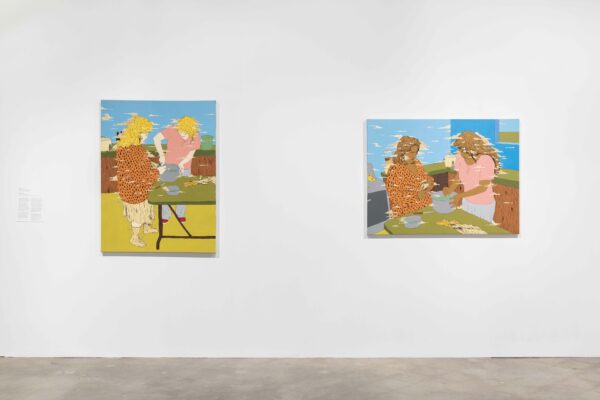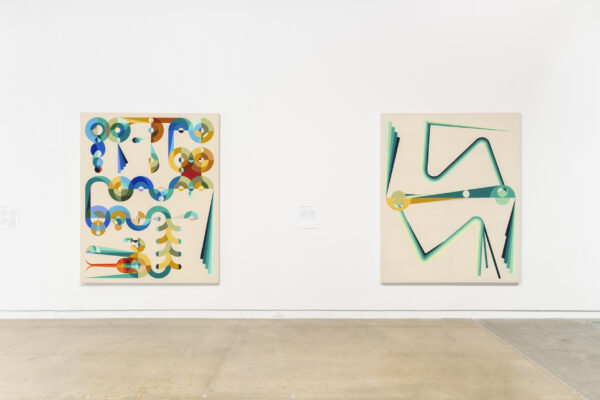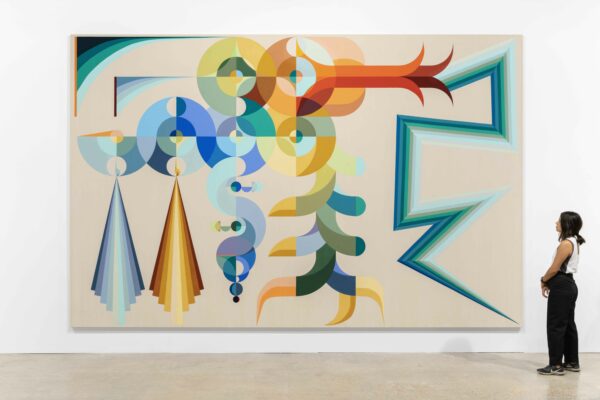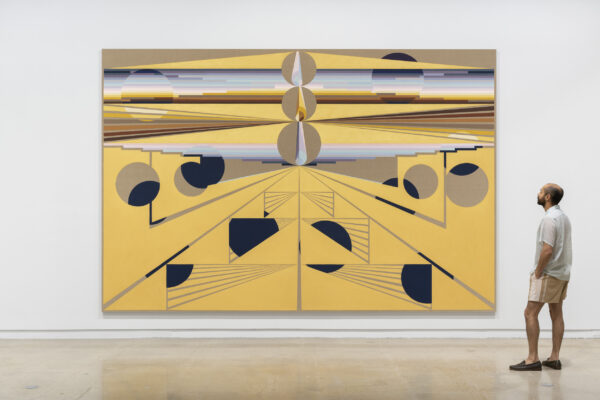In his seminal 1855 poem “Song of Myself,” Walt Whitman wrote: “Do I contradict myself? / Very well then I contradict myself, / (I am large, I contain multitudes).” Whitman demonstrates throughout his poem that we are constantly responding to the transforming stimuli of the many worlds that surround us. He recognized the complexity of humanity. We are not one identity; we are continually evolving, expanding.
Eamon Ore-Giron’s first comprehensive museum retrospective acknowledges some of these multitudes with its confluence of influences that explore the layers of multicultural identity and the intersection of European and Latin American abstraction in a post-colonial world. On view at The Contemporary Austin, featuring over two decades of work, Competing with Lightning/Rivalizando con el Relámpago includes the artist’s early figurative paintings from the early 2000s, his movement into abstraction with his Talking Shit series, and new works from his latest series, Infinite Regress.
In order to understand Ore-Giron’s current work, it’s important to return to his roots. Although now based in Los Angeles, the artist grew up in Tucson with an Irish-American mother and an Indigenous father from Peru, and the resulting cultural hybridity spurred many of Ore-Giron’s artistic inquiries. Throughout his childhood, the artist traveled frequently to South America; he later began using personal slides from his family gatherings as source material for his figurative paintings. The first floor of the exhibit sets the stage for not only how the artist works with blocks of color (which he picked up from an apprenticeship with Peruvian painter Josué Sánchez), but also provides a look into his family history.
These early works represent a variety of memories engaging with the domestic and folk traditions of Peruvian culture, which were themselves a hybrid of influences from both European and Latin American customs and beliefs. Viewers will observe painted scenes of the Chonguinada dancers of Huamanga, Peru (a dance that symbolically references the centuries-long practice of intermarriage between the Spanish colonists and the Indigenous populations).
One will also witness domestic scenes of women making humitas, a South American version of the tamale, as seen in Cookin’ 1 and Cookin’ 2, both completed in 2002. The figures in these paintings are based on photographs of Ore-Giron’s aunt and cousin preparing a traditional Peruvian Pachamanca feast. Yet in one painting the figures have blonde hair and pale skin and in the other the women have brown skin and hair, perhaps a reference to the many ways in which Indigenous and white cultures blend and remix throughout the American Southwest, Ore-Giron’s home.

Installation view, “Eamon Ore-Giron: Competing with Lightning / Rivalizando con el relámpago” at The Contemporary Austin – Jones Center on Congress Avenue, Austin, Texas, 2023. Artwork © Eamon Ore-Giron. Image courtesy The Contemporary Austin. Photograph by Alex Boeschenstein.
Move into the upstairs galleries and you wade into a conversation between America’s pre-Columbian history and 21st-century aesthetics. First developed while at an artist residency in Guadalajara, Mexico in 2017, Ore-Giron’s Talking Shit series reimagines Aztec deities like Quetzalcoatl and Coatlicue, and in a more recent work, the Incan deity Amaru. These large-scale canvases combine the hard edges of geometric abstraction with Mesoamerican elements. For example, in Talking Shit with Quetzalcoatl (2017), the artist has reinterpreted the snake-like body of the plumed serpent deity into clearly defined geometric shapes. His use of Flashe, a vinyl-based paint with an ultra-matte finish, adds to the flatness of the work. The colors are saturated and vibrant.
While Ore-Giron pulls from Indigenous design, he also cites a long list of artistic influence from Modernist abstract painters: Cuban minimalist Carmen Herrera, Uruguayan painter María Freire, the Brazilian Neo Concrete artists Hélio Oiticica, Lygia Pape, and Lygia Clark, as well as European-centric artists like Wassily Kandinsky, László Mhology-Nagy, and Jean Arp. In his work, Ore-Giron creates a space where both Indigenous and European influences can coexist. With this series as a whole, the artist explores the question: how do these depictions of divinity “function as symbols of identity and Indigeneity in an era when individual and collective identities are ever more complex and nuanced?”

Installation view, “Eamon Ore-Giron: Competing with Lightning / Rivalizando con el relámpago” at The Contemporary Austin – Jones Center on Congress Avenue, Austin, Texas, 2023. Artwork © Eamon Ore-Giron. Image courtesy The Contemporary Austin. Photograph by Alex Boeschenstein.

Eamon Ore-Giron, “Talking Shit with Amaru, 2021, mineral paint and Flashe on canvas, 132 x 204 inches. Installation view, “Eamon Ore-Giron: Competing with Lightning / Rivalizando con el relámpago” at The Contemporary Austin – Jones Center on Congress Avenue, Austin, Texas, 2023. Artwork © Eamon Ore-Giron. Courtesy the artist and James Cohan, New York. Image courtesy The Contemporary Austin. Photograph by Alex Boeschenstein.
Ore-Giron expands and refines his language of geometric forms in his most recent series, Infinite Regress. The term references the concept of circular reasoning, as seen in Infinite Regress CLXXXVIII (2021), wherein one element in the composition begets the next, ad infinitum. In theory, there is no beginning and no end, though here the end lies in the edges of the raw linen canvas, a material that evokes the color of both brown skin and brown earth.
Each composition includes a system or patterns of converging lines that vanish deep into the horizon. With some canvases, like Infinite Regress CLXXXVI (2021), I felt as if I was staring down a desert road stretching into infinity, the future unknown. Ore-Giron has described these vanishing points as the place where “future, past, and present meet.”
Within each composition are circular shapes or orbs that feel celestial in quality: planets, moons, suns. These cosmic arrangements have relationships with pre-colonial architecture, connecting to shapes found in the pyramids of Mexico, the adobe structures of the Pueblo peoples of the Southwest, or even the huacas of Peru, which are sacred sites thought to be manifestations of both the natural and supernatural world.
But for Ore-Giron’s orbs, their origins are more ordinary in nature. He traces acetate dubplates that he uses in his work as a DJ to create the circular patterns in this painted series. Known as DJ Lengua, Ore-Giron thinks about his music projects similar to his paintings: as a way to dig through the past, whether that’s through sounds and rhythms in music or the various formal elements of art and culture, to form different relationships and create something new.
His prominent use of gold in the Infinite Regress series is one such archaeological excavation. Ore-Giron is looking at the colonial history of gold, particularly in Latin America and his father’s homeland of Peru, where Spanish colonizers mined the mineral, stripping it from Inca temples. For the artist, thinking about these lost objects — Peruvian, Mexican, Colombian — his paintings in gold have become a way to reclaim and push against that destruction of culture and history of erasure. As an aesthetic choice, in contrast to the brown linen of the canvas, the gold helps bring forward the patterns of shapes, almost like floating sculptural forms, creating new relationships within the confines of each composition.

Eamon Ore-Giron, “Infinite Regress CLXXXIX,” 2021, mineral paint and Flashe on linen, 120 x 180 inches. Installation view, “Eamon Ore-Giron: Competing with Lightning / Rivalizando con el relámpago” at The Contemporary Austin – Jones Center on Congress Avenue, Austin, Texas, 2023. Artwork © Eamon Ore-Giron. Courtesy the artist and James Cohan, New York. Image courtesy The Contemporary Austin. Photograph by Alex Boeschenstein.

Eamon Ore-Giron, “Infinite Regress CLXXXVIII,” 2021, mineral paint and Flashe on linen. 120 x 156 inches. Installation view, “Eamon Ore-Giron: Competing with Lightning / Rivalizando con el relámpago” at The Contemporary Austin – Jones Center on Congress Avenue, Austin, Texas, 2023. Artwork © Eamon Ore-Giron. Courtesy the artist and James Cohan, New York. Image courtesy The Contemporary Austin. Photograph by Alex Boeschenstein.
As the exhibit Competing with Lightning/Rivalizando con el Relámpago suggests, Eamon Ore-Giron creates a space in his work where Indigenous and European worlds collide, mixing influences and formal elements to create new forms. The work is visually stimulating and delightful to the senses while also sparking curiosity and critical reflection. Through abstraction, Ore-Giron has developed a new language through which to explore the complexities of colonialism and the blending of cultures that have not only shaped his childhood and career, but the world in which we live in today.
Competing with Lightning/Rivalizando con el Relámpago is curated by Miranda Lash, Ellen Bruss Senior Curator, Museum of Contemporary Art Denver. The presentation at The Contemporary Austin is organized by Julie Le, Assistant Curator. The exhibition is on view at The Contemporary Austin through August 20, 2023.


